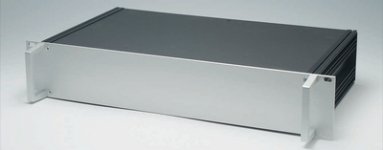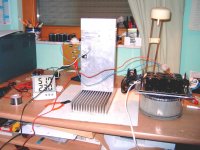Hello,
this is just another heatsink question: Does the orientation of heatsink matter (horizontal or vertical fins)?
I think that vertical fins are better, but horizontal would be better for my construction. I have heatsinks 0.8K/W/10cm and I would like to use 40cm lenght for 150W dissipiation.
Side view (fins)
_________________
_________________
_________________
_________________
or
| | | | | | | | | | |
| | | | | | | | | | |
| | | | | | | | | | |
| | | | | | | | | | |
this is just another heatsink question: Does the orientation of heatsink matter (horizontal or vertical fins)?
I think that vertical fins are better, but horizontal would be better for my construction. I have heatsinks 0.8K/W/10cm and I would like to use 40cm lenght for 150W dissipiation.
Side view (fins)
_________________
_________________
_________________
_________________
or
| | | | | | | | | | |
| | | | | | | | | | |
| | | | | | | | | | |
| | | | | | | | | | |
Cooling largely depends on natural air flow, ( without fans , of course) thus vertical fins are definately more effective...although radiation also plays some role.
You loose some 20-30%, or more at worst, by horisontal orientation, depending on fin depth, distance between fins etc. The deeper and closer the fins are, the more you loose, as natural air flow is less efficient.
If the sinks you have are marginal, you will win some by cutting in 4 pieces and mounting them vertical....
There should be some info at the web sites of the heatsink mfgrs..
Can't remember where..
You loose some 20-30%, or more at worst, by horisontal orientation, depending on fin depth, distance between fins etc. The deeper and closer the fins are, the more you loose, as natural air flow is less efficient.
If the sinks you have are marginal, you will win some by cutting in 4 pieces and mounting them vertical....
There should be some info at the web sites of the heatsink mfgrs..
Can't remember where..
the sinks won't be .8K/W/10CM with the fins horizontally. Not to say it cannot be done, see the X150.5 and X250.5 on the pass labs website.
the safest way is to see if it will work is to try it - mount a load (your amp or some power resistors) on the sinks and measure the temperature rise with the load you expect.
the safest way is to see if it will work is to try it - mount a load (your amp or some power resistors) on the sinks and measure the temperature rise with the load you expect.
that still won't be as thermally efficient as cutting the extrusions as AuroraB suggested, but will probably be better than horizontal mounting. The top of the sink sees the hot air rising from the lower parts. I think it is AAVID's website that has a calculator that allows you to plug in the extrusion length and get the performance.
For class B it is not problem, but I'm building class A amp.
I have heatsinks now with vertical fins for my current project (200x400x61mm), but I want to build something small.
These sinks are made of 4 separate sinks connected to 10mm al plate. So maybe I should do the same with smaller ones, but it's a lot of work and I'm too lazy so I wanted to place just 1 long sink without plate in horiz. position.
I have heatsinks now with vertical fins for my current project (200x400x61mm), but I want to build something small.
These sinks are made of 4 separate sinks connected to 10mm al plate. So maybe I should do the same with smaller ones, but it's a lot of work and I'm too lazy so I wanted to place just 1 long sink without plate in horiz. position.
Try it easy.
I tried my heatsink with a CCS and one IRFP254 by 44W dessipation. (22V/2A FET). My heatsink (one piece) is 300x140x40mm big.
This heat up approx. 30°C above ambient.
I turned them flat (horizontal fins) so this heat up 6°C more.

I hope this helps.
Regards
Adam
I tried my heatsink with a CCS and one IRFP254 by 44W dessipation. (22V/2A FET). My heatsink (one piece) is 300x140x40mm big.
This heat up approx. 30°C above ambient.

I turned them flat (horizontal fins) so this heat up 6°C more.


I hope this helps.
Regards
Adam
Attachments
Put the heatsink vertical and stick a piece of board with tape to the open side.
Notice the difference, nothing beats a chimney.
Pass has special winged heatsinks, like the ones for the volksamp. The fins on those heatsinks are not horizontal.
Even two heatsinks placed vertical on top of eachother have a worse thermal factor than placed next to eachother.
So basically it is better to go deeper than high.
Exactly what was standard for big class A amps, same height but up to 50 % more chassis depth.
Think Krell's, Thresholds, Jeff Rowland
(or was it Rowland Research then ?)
The top models were 30" deep.
A remarkable design that used heatsinks to the max was the Audio Analyse A90. All the heatsinks on top of the amplifier chassis.
Notice the difference, nothing beats a chimney.
Pass has special winged heatsinks, like the ones for the volksamp. The fins on those heatsinks are not horizontal.
Even two heatsinks placed vertical on top of eachother have a worse thermal factor than placed next to eachother.
So basically it is better to go deeper than high.
Exactly what was standard for big class A amps, same height but up to 50 % more chassis depth.
Think Krell's, Thresholds, Jeff Rowland
(or was it Rowland Research then ?)
The top models were 30" deep.
A remarkable design that used heatsinks to the max was the Audio Analyse A90. All the heatsinks on top of the amplifier chassis.
- Status
- This old topic is closed. If you want to reopen this topic, contact a moderator using the "Report Post" button.
- Home
- Amplifiers
- Pass Labs
- Another heatsink question

